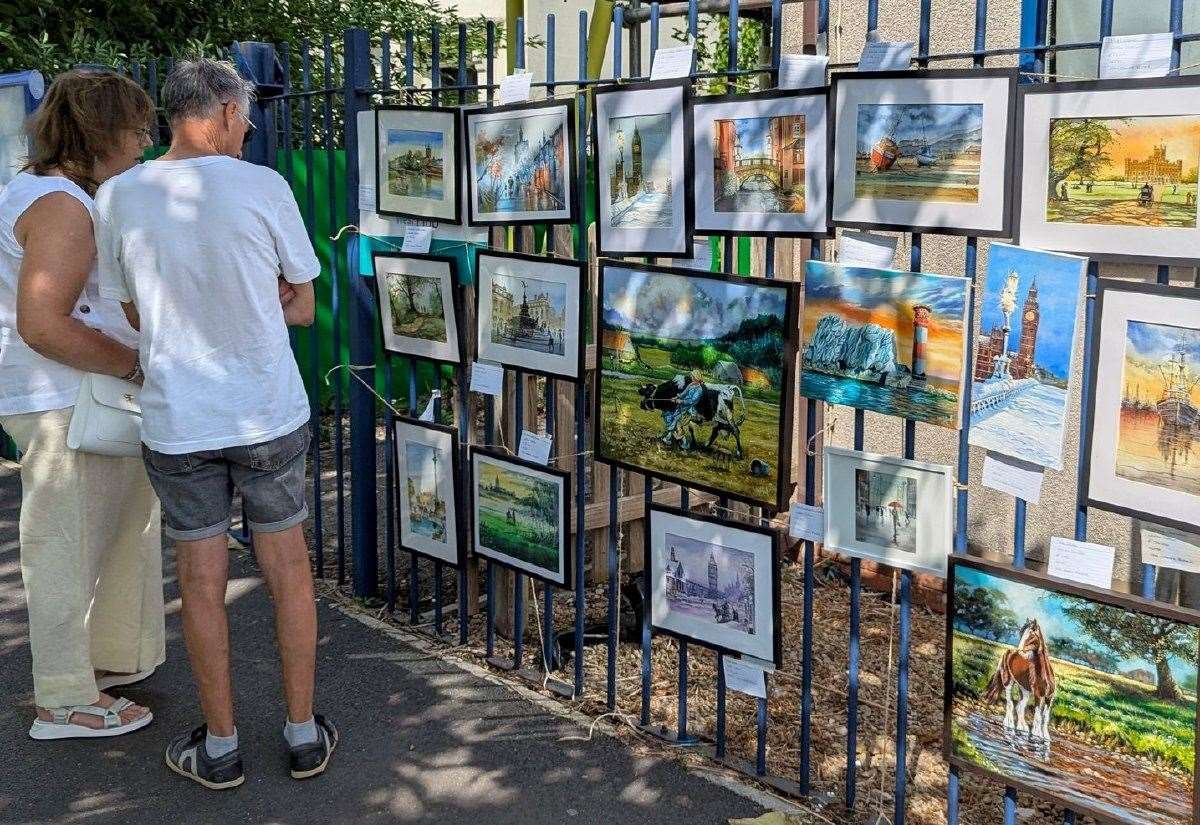Michael Schlicting was never supposed to move back home.
Born and raised in the tiny town of Neskowin on the Oregon coast, the younger Schlicting, like many teenagers, always imagined he would leave for the “outside world” — somewhere, anywhere but where he was from. But the allure of home proved powerful.
It’s now been nearly half a century since Schlicting left those outside places — college in Illinois, a stint in Colorado — to return to Oregon, back to his hometown of Neskowin, where in 1978 he set up his Hawk Creek Gallery in a historic schoolhouse on the side of U.S. 101. That first summer back, when he never expected to stay, he drew people in with a simple sandwich board on the highway, the word “ART” and an arrow pointing to the gallery.
Enough people showed up, and enough people bought his paintings, that he was persuaded he should stick around and give it a try.
“At first it was because I did miss the ocean,” Schlicting said of his decision to come back. “As time has gone on, years and decades, half a century, there is a sense of place that’s kind of the cliché, but your history, the history of the people you’ve come to know … there’s that shared sense of history.
“Neskowin’s a pretty special place. It’s small, it’s unique.”


The little town is nestled up against a sweeping headland, Cascade Head, on the north-central Oregon coast. With no shops, few restaurants and no big attractions to speak of, it’s one of the coast’s quietest vacation destinations. People are drawn there largely for the beach scenery: stately Proposal Rock, a sea stack topped with a small forest, or the eerie Ghost Forest, ancient stumps that emerge from the sand at low tide.
Anyone can step outside to see those landscapes, but many choose to get a second look through Schlicting’s eye. His paintings of Neskowin are everywhere. You can find them in galleries, on the walls of the neighboring Cafe on Hawk Creek or in the many charming beach cottages that populate the town. He’s painted enough pictures of Proposal Rock to compile a book, “Proposal Rock: 40 Years of Paintings,” which has sold out two printings.
Stroll through the Hawk Creek Gallery and you’ll see those landscapes. Sometimes the coast is shown realistically in its bright greens and blues, or its hazy grays and browns. But more often than not, Schlicting’s current work brings in bright, kaleidoscopic color, adding fanciful abstraction to the beach scenes.
“I like strong color,” he said. “Sometimes it’s illusionistic and [sometimes] realistic.”



Strolling through his gallery, he walked over to a painting not from the coast but from the mountains. Called “Across the Great Divide,” the acrylic painting was after on a trip over the Wind River Range in Wyoming. The landscape is dominated by bright red hills that sweep across the canvas. A dark green range looms behind, and the scene is dotted with puffy patches of yellow aspen trees. Craggy peaks peek up from the corner.
“It was in the fall and of course the color wasn’t this red, but I really liked this red against the dark green,” Schlicting said, remembering his process. “It’s very intentionally being, you know, abstraction.” He swept his hand swiftly back and forth along the canvas. “Movement, shape, color.”
Schlicting started his career doing watercolors, quickly earning a name for himself in the international art scene. He won awards, sold to galleries and led workshops around the world. A sojourn to Chile in 1994 (one of many) inspired him to pivot to acrylics, a change that was cemented after teaching workshops in Italy, another landscape that has drawn his eye.
On the other side of his gallery, Schlicting talked about his piece “Finding Solomeo,” a geometric painting inspired by a real-life adventure with friends through the Italian countryside. On a whim, they decided to seek out the village of Solomeo, which is home to luxury fashion designer Brunello Cucinelli. The painting started out more realistic, a picture of a little Italian village, he said, but quickly morphed as his brush abstracted the scene with arches, columns, steps and hills — shapes and colors covering up the fields of little flowers.
“When I start a painting, I want it to take off on its own life, and not me impose something,” he said. “‘Finding Solomeo’ is both us finding it literally, and then the other was just me finding the soul of [the painting].”


Schlicting, now in his 70s and well established, said he feels like he has nothing left to prove. His artistic process can be free. His success also brings a level of freedom, even if the steady flow of commissions keeps him busier than he would sometimes like. After 47 years, the artist clearly become a fixture of the community — easily Neskowin’s most famous resident — but when asked about it, he brushed off the notion with a twinge of unease. “Even in a place as small as Neskowin, there are a lot of people that are fixtures,” he said.
His laid-back demeanor makes it easy to mistake Schlicting for just another small-town artist. But when he, for example, offhandedly mentions that he recently sold dozens of paintings to the upscale Headlands Coastal Lodge in Pacific City — including a striking three-panel depiction of Cape Kiwanda in which the landscape gives way to a busy scene of dory boats, swimming fish and waves, the colors cutting geometric shapes through the reflections in the wet sand — you begin to understand that he’s far from ordinary.
Schlicting is dedicated to his hometown. This summer, he is putting out a new book, not of paintings but of local historic photographs. The 320-page coffee table book, “Neskowin: A Book of Found Photos,” is a love letter to the place that he couldn’t bring himself to leave.
“There is now a much deeper resonance for me of being here, and being of a place and embracing it,” he said.
Schlicting said sense of place is important for an artist. Where you grew up — whether on Kansas plains, among Manhattan skyscrapers or on the rugged Oregon coast — will affect your sense of spatial awareness. When painting the streets of Chile, Schlicting found himself drawn to little alcoves and alleyways, which he said reminded him of exploring Oregon coast sea caves.
In other words, he paints from the place he is from, no matter where he goes.
“‘Out there,’” he said, reflecting on his childhood dreams of leaving home, “What does that even mean?”
“I’ve had a lot of success in the larger world, I’ve had some amazing opportunities that were given to me, but you know, I’m happy to be a Neskowin painter.”
If you purchase a product or register for an account through a link on our site, we may receive compensation. By using this site, you consent to our User Agreement and agree that your clicks, interactions, and personal information may be collected, recorded, and/or stored by us and social media and other third-party partners in accordance with our Privacy Policy.






